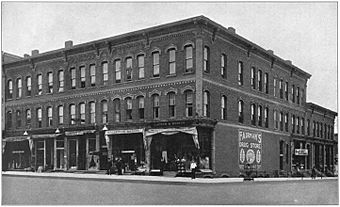Fairman Building facts for kids
Quick facts for kids |
|
|
Fairman Building
|
|

Fairman Building c. 1906
|
|
| Location | 102-106 S. Michigan Ave., Big Rapids, Michigan |
|---|---|
| Area | less than one acre |
| Built | 1880 |
| Built by | Crocker & Hudnutt |
| Architect | Crocker & Hudnutt |
| Architectural style | Italianate |
| NRHP reference No. | 87000072 |
| Added to NRHP | February 12, 1987 |
The Fairman Building is a historic building in Big Rapids, Michigan. You can find it at 102-106 South Michigan Avenue. This building is so special that it was added to the National Register of Historic Places in 1987. This list helps protect important places in the United States.
History of the Fairman Building
The Fairman Building was built by a man named Ferdinand Fairman. He was born in New York in 1833. Ferdinand started as a teacher and later owned a general store. He was very good at business!
In 1873, Ferdinand Fairman moved to Big Rapids, Michigan. He saw a lot of opportunities there. Big Rapids was a busy lumber town back then. Ferdinand got involved in real estate and other businesses. He even started his own bank!
In 1880, Ferdinand Fairman hired a company called Crocker and Hudnutt. They designed and built this large commercial building. His bank was located inside the Fairman Building for many years. It was the biggest business building in Big Rapids at the time.
Years later, in 2003, the Fairman Building got a new purpose. It was renovated along with a nearby building, the Nisbett Building. Now, both buildings are called the Nisbett-Fairman Residences. They provide homes for senior citizens.
What the Fairman Building Looks Like
The Fairman Building is a three-story building made of red brick. It has a special style called Italianate architecture. This style was popular in the late 1800s.
The building is located where Maple and South Michigan streets meet. It has two main sides that face the streets. You can see many large windows and doorways where shops used to be.
The corners of the building have light-colored bricks, which make them stand out. At the very top, there's a decorative metal edge called a cornice. It has brackets that help support it and add to the building's classic look.
Images for kids
-
The Nisbett Building (left) and Fairman Building (right) around 1906.





